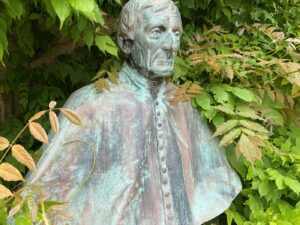Civil authorities, James Madison noted, are particularly incompetent judges of religious truth. The First Amendment Madison helped shepherd through the First Congress thus explicitly protected establishments of religion from governmental meddling. History, however, has repeatedly shown the difficulty of drawing bright lines between the sacred and the secular, and the Supreme Court has long faced the delicate task of adjudicating disputes between the two. One such dispute currently pending before the High Court will decide the degree to which the religion clauses of the First Amendment insulate the employment decisions of religious organizations from federal anti-discrimination statutes.
Both the Civil Rights Act and the Americans with Disabilities Act contain statutory exemptions that allow religious institutions to engage in religious discrimination. A church or religious school may, for example, require all employees to sign a statement of faith or otherwise maintain fidelity to the religious tenets of the organization. But the statutes do not grant exemptions for other forms of prohibited discrimination based on race, sex, ethnicity, national origin, or disability. So what about a religious organization that, say, restricts the priesthood to males or requires rituals to be performed by people of a particular ethnic group?
For this, judges have crafted a First Amendment exception to general anti-discrimination laws, granting religious organizations broad discretion to staff “ministerial” positions based on whatever criteria they choose. The actual language of the First Amendment prohibits congressional legislation “respecting an establishment of religion or prohibiting the free exercise thereof,” and the judicially created “ministerial exception” to anti-discrimination statutes presumes that a law limiting a church’s discretion to hire ministers would be an affront to both sides of the establishment/free exercise coin. Immediately at issue in Hosanna-Tabor Lutheran Church and School v. EEOC is what counts as a “ministerial” position—and who gets to decide.
After Cheryl Perich took a medical leave of absence from her job as a teacher at a Lutheran elementary school in Redford, Michigan, there was a dispute over whether, and on what terms, she would return to work. When she threatened to sue the congregation under the Americans with Disabilities Act, the voting members of the church removed her for failing to follow accepted ecclesiastical procedures for internal dispute resolution. Federal law prohibits retaliatory firing for claims made under the ADA, and Perich insists the law applies to her because she was not employed in a ministerial role. The church claims otherwise, having long categorized Perich as a “commissioned minister.”
If the Supreme Court sides with Perich, it will essentially invite federal review of religious organizations’ own designations of ministerial offices. On what basis, then, might courts decide whether specific offices are sufficiently ministerial? Perich’s attorney suggested during oral arguments that the principal question should be whether a particular employee carries out “important secular functions in addition to her religious duties.” But, as Chief Justice John Roberts pointed out, that test is entirely unworkable. The Pope is a head of state with important secular duties. So, Roberts asked rhetorically, is he not a minister? To limit the exception to employees whose functions are entirely religious would be to make the exception meaningless. Sorting out the religious from the secular duties of church employees would also necessarily embroil courts in theological disputes, since various religious traditions differ in the ways they conceive the religious nature of particular offices and vocations.
Start your day with Public Discourse
Sign up and get our daily essays sent straight to your inbox.Several groups have brought up an additionally thorny question of whether the decision to fire Perich was sufficiently “religious,” and an amicus brief signed by Americans United for Separation of Church and State and the American Civil Liberties Union suggests “courts can and should use their considerable experience in determining whether sincere religious views animated a litigant’s conduct.” If such groups have their way, federal courts will be in the business of weighing the sincerity of the religious motivations for the employment decisions of religious organizations.
An even worse outcome for religious liberty would be for the Court to drop the ministerial exception altogether and hold every employment decision—ministerial or not—subject to federal oversight. This would create an awkward and unprecedented commingling of government and religion, with federal courts essentially mediating ecclesiastical disputes regarding the fitness of individuals for positions of church leadership. While neither Perich nor the church has explicitly advocated abandoning the ministerial exception, other serious voices have.
One of those voices is that of the Obama Administration, whose Department of Justice filed an opposition brief encouraging the Court to reject the ministerial exception outright. During oral arguments, Acting Deputy Solicitor General Leondra Kruger insisted that the “insight of the ministerial exception” is merely that it will sometimes take an “extraordinarily compelling governmental interest” to justify interference with a religious organization. Churches and other religious groups, Kruger conceded, have certain associational rights under the First Amendment, but she provocatively claimed that the “basic contours of the inquiry” in religion cases were no different than in any other case involving associational rights. Kruger’s argument thus minimized the importance of the religion clauses of the First Amendment to the rights of religious organizations, and, as Justice Antonin Scalia maintained, the government’s contention here was “extraordinary.” Right “there, black on white in the text of the Constitution are special protections for religion,” Scalia noted. “And you say it makes no difference?”
The Obama Administration’s position may have been extraordinary, but it was not original. Soon after the Court agreed to hear the case, University of Houston law professors Leslie Griffin and Ronald Turner suggested “[r]eligions should not be authorized to create a zone of employment autonomy outside the review of the courts.” For support, Griffin and Turner appeal to the logic of Scalia’s opinion for the Court in Employment Division v. Smith (1990), a landmark case involving two private drug-rehab counselors who were denied unemployment benefits by the state of Oregon after they were fired for ingesting peyote as part of a religious ritual.
The Smith case would have been uncontroversial had the counselors been recreational drug users. Because their use of peyote was religiously motivated, however, they sought an exception to the generally applicable law. Scalia and the Court balked, arguing that creating a religious exception to every general statute would be tantamount to making “the professed doctrines of religious belief superior to the law of the land, and in effect to allow every citizen to become a law unto himself.” Just as individuals cannot claim a religious right to skirt laws banning polygamy, evade social security taxes, employ children as laborers, or avoid Sunday closing laws, they cannot claim a religious right to use an illicit drug.
Yet religious exceptions to generally applicable criminal laws that do not implicate other constitutional rights are conceptually different from religious exceptions to anti-discrimination statutes. As Scalia pointed out, Smith “had nothing to do” with church employment decisions, and although there may not be a constitutional right to use peyote—even for religious purposes—there is undoubtedly a strong constitutional basis for claiming independence in the matter of staffing a religious organization. If the First Amendment means anything, it means the government should not choose the officers of a church. But consider the following scenario: A local congregation runs a private, sectarian elementary school. The congregation considers some of its teachers to be “commissioned ministers” with religious vocations, and the authority to hire these teachers is given to the voting members of the church. After an internal dispute, the congregation votes to fire one of its teachers. The Equal Employment Opportunity Commission then files a complaint with a federal court, and the church is forced by the government to maintain on its payroll a minister whom it decided to fire.
This is precisely what is at stake in Hosanna-Tabor v. EEOC, and its importance is heightened because it is an issue of first impression for the Supreme Court. Although slippery slope arguments are not always sound, it is easy to see what will happen if the ministerial exception is weakened or abandoned. Religious organizations will become increasingly subject to anti-discrimination laws having to do with a host of categories hitherto unimagined, and the underlying religious motivations for staffing decisions will be subject to judicial interpretation and review.
“It may not be easy,” Madison acknowledged nearly a half-century after the adoption of the First Amendment, “in every possible case, to trace the line of separation between the rights of religion and the civil authority with such distinctness as to avoid collisions and doubts on unessential points.” The decision to hire or fire clergy, however, is hardly an “unessential” point, and there should be no doubt that the First Amendment takes such decisions away from the civil authority.









